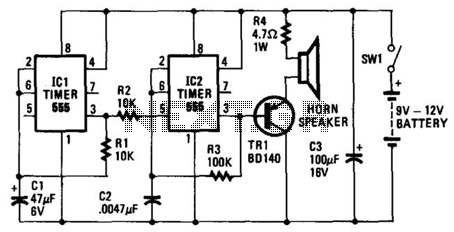
Hee-haw

The circuit utilizes two gates from a 7400 integrated circuit, cross-connected to create an astable multivibrator that is driven by the one pulse per second output from a digital clock integrated circuit. Additionally, the circuit incorporates a low-frequency astable modulator to form a self-contained European-type siren. The tone and rate of the siren can be adjusted by changing the capacitor values. Furthermore, if the tone produced is excessively harsh, a simple resistor-capacitor (R-C) filter can be employed to eliminate the harmonic content, as the output of the multivibrator is nearly a square wave. The specified resistor values ensure that there are no startup issues; however, significant alterations to the 2.2 kΩ or 2.7 kΩ resistor values may lead to latch-up problems.
The circuit design described employs a 7400 IC, which contains four NAND gates, configured to function as an astable multivibrator. In this configuration, two of the gates are used in a feedback loop that generates a continuous square wave output. The frequency of oscillation is determined by the values of the resistors and capacitors connected to the gates. The output frequency is set to one pulse per second, providing a steady timing signal that can be used to drive other components within the circuit.
The astable multivibrator's output is characterized by its square wave nature, which can produce a harsh tone when directly fed into a speaker or other audio output device. To mitigate this, an R-C filter can be integrated into the circuit. This filter smooths out the sharp edges of the square wave, thereby reducing the harmonic content and producing a more pleasant sound.
The design allows for flexibility in sound modulation. By varying the capacitance in the circuit, users can adjust both the tone and the rate of the siren. This feature is particularly useful for applications requiring different alert tones or signaling patterns.
Careful attention must be paid to the resistor values used in the circuit. The specified 2.2 kΩ and 2.7 kΩ resistors are critical to ensuring stable operation and preventing latch-up conditions that can occur if the resistances are altered too drastically. Latch-up can lead to unintended behavior in digital circuits, making it essential to maintain the integrity of the circuit design through careful component selection and configuration.
Overall, this circuit provides a simple yet effective solution for generating a European-type siren sound, with adjustable parameters for tone and frequency, while maintaining stability and performance through careful design considerations.The circuit uses two gates of a 7400 IC cross-connected to form an astable multivibrator driven by the 1-pulse per second output of the digital clock IC. The hee-haw circuit has a low frequency astable modulator added to make a self-contained European-type siren.
Tone and rate can be varied as desired by changing capacitor values. If the tone is too harsh, a simple R-C filter will remove the harmonic content— the multivibrator output is almost a square wave. With the resistor values shown, no startup problems occur; but if the 2.2 k or 2.7 k resistors are changed too much, latch-up can be a problem.
The circuit design described employs a 7400 IC, which contains four NAND gates, configured to function as an astable multivibrator. In this configuration, two of the gates are used in a feedback loop that generates a continuous square wave output. The frequency of oscillation is determined by the values of the resistors and capacitors connected to the gates. The output frequency is set to one pulse per second, providing a steady timing signal that can be used to drive other components within the circuit.
The astable multivibrator's output is characterized by its square wave nature, which can produce a harsh tone when directly fed into a speaker or other audio output device. To mitigate this, an R-C filter can be integrated into the circuit. This filter smooths out the sharp edges of the square wave, thereby reducing the harmonic content and producing a more pleasant sound.
The design allows for flexibility in sound modulation. By varying the capacitance in the circuit, users can adjust both the tone and the rate of the siren. This feature is particularly useful for applications requiring different alert tones or signaling patterns.
Careful attention must be paid to the resistor values used in the circuit. The specified 2.2 kΩ and 2.7 kΩ resistors are critical to ensuring stable operation and preventing latch-up conditions that can occur if the resistances are altered too drastically. Latch-up can lead to unintended behavior in digital circuits, making it essential to maintain the integrity of the circuit design through careful component selection and configuration.
Overall, this circuit provides a simple yet effective solution for generating a European-type siren sound, with adjustable parameters for tone and frequency, while maintaining stability and performance through careful design considerations.The circuit uses two gates of a 7400 IC cross-connected to form an astable multivibrator driven by the 1-pulse per second output of the digital clock IC. The hee-haw circuit has a low frequency astable modulator added to make a self-contained European-type siren.
Tone and rate can be varied as desired by changing capacitor values. If the tone is too harsh, a simple R-C filter will remove the harmonic content— the multivibrator output is almost a square wave. With the resistor values shown, no startup problems occur; but if the 2.2 k or 2.7 k resistors are changed too much, latch-up can be a problem.


